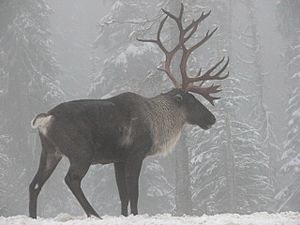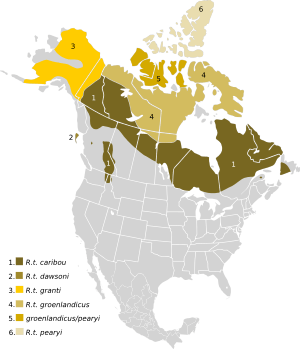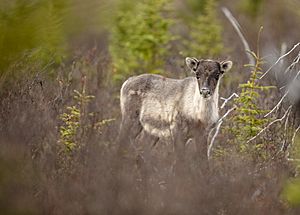Boreal woodland caribou facts for kids
Quick facts for kids Boreal woodland caribou |
|
|---|---|
 |
|
| A boreal woodland caribou in the Selkirk Mountains of Idaho. | |
| Conservation status | |
| Scientific classification |
|
| Kingdom: | Animalia |
| Phylum: | Chordata |
| Class: | Mammalia |
| Order: | Artiodactyla |
| Family: | Cervidae |
| Subfamily: | Capreolinae |
| Genus: | Rangifer |
| Species: | |
| Subspecies: |
R. t. caribou
|
| Trinomial name | |
| Rangifer tarandus caribou (Gmelin, 1788)
|
|
 |
|
| The red area shows the approximate range of boreal woodland caribou in North America. | |
The boreal woodland caribou is a North American subspecies of reindeer. You can find them mostly in Canada's vast boreal forests, with some small populations once living in the United States.
Unlike other famous caribou herds that travel thousands of kilometers, boreal woodland caribou are mostly sedentary. This means they stay in a smaller, familiar area all year round. They are known for being shy and hard to spot in the dense forest.
Sadly, the boreal woodland caribou is a threatened species. Their forest homes are shrinking due to human activity, and their numbers have been dropping for many years.
Contents
What Do Boreal Woodland Caribou Look Like?
Boreal woodland caribou are a medium-sized member of the deer family. They can stand about 1 to 1.2 meters (3 to 4 feet) tall at the shoulder and weigh between 110 and 210 kilograms (242 to 462 pounds).
They are well-adapted for life in the cold. Their bodies are covered with a thick, long brown coat that turns more grayish in the winter. A key feature is their creamy-white neck, mane, and belly.
Antlers and Hooves
Both male and female boreal woodland caribou can grow antlers, although some females may have only one or none at all. A male's antlers grow very quickly each year, starting as small bumps in the spring and becoming a large rack by the end of summer. Their antlers are flatter and more compact than those of other caribou.
Caribou have amazing hooves that are large and crescent-shaped. These hooves act like snowshoes, helping them walk on top of deep snow. They also use their hooves to dig through the snow to find their favorite food, lichen.
Habitat and Range
Boreal woodland caribou live in the boreal forest, a huge stretch of wilderness that crosses much of Canada. They prefer mature, old-growth forests that are rich in lichens. They also spend a lot of time in marshes, bogs, and near lakes and rivers.
Historically, these caribou lived across more than half of Canada, from the Yukon all the way to Newfoundland and Labrador. Their range also stretched south into the northern United States. Today, their range has shrunk dramatically. There are about 34,000 boreal woodland caribou left in Canada, living in 51 separate groups, or ranges.
Behavior and Life Cycle
Boreal woodland caribou are much more solitary than their migrating cousins. They live in small groups and do not form the massive herds seen in the tundra. Their seasonal movements are also much shorter, usually less than 150 kilometers.
Breeding happens in the fall, and calves are born in the late spring, usually in May or June. A mother caribou will find a secluded spot, like an island in a lake or a deep bog, to give birth alone. She and her calf will stay hidden from the rest of the herd and from predators like wolves and bears until the calf is strong enough to keep up. This solitary calving is a key survival strategy, but it also makes the mothers and calves very vulnerable.
How long do they live?
The boreal woodland caribou typically has a lifespan of 8 to 15 years in the wild.
A Species at Risk
In 2002, the boreal woodland caribou was officially listed as a threatened species in Canada. This means it is likely to become endangered if steps are not taken to protect it. Scientists believe that only about 30% of Canada's boreal caribou herds are large enough to survive on their own without help.
Why Are They in Trouble?
The biggest threat to the caribou is habitat loss and fragmentation. Human activities like logging, mining, and oil and gas exploration have cut their vast forest home into smaller, disconnected pieces.
- Habitat Fragmentation: Roads, pipelines, and seismic lines (paths cleared for oil and gas surveys) create openings in the forest. This makes it harder for caribou to find food and avoid danger.
- Increased Predators: These new clearings and roads attract other animals like moose and deer. More moose and deer mean more wolves, which are the caribou's main predator. The roads and seismic lines also act like highways for wolves, making it easier for them to travel and hunt caribou.
Because of these changes, fewer caribou calves are surviving their first year of life.
Conservation: How People Are Helping
Many people are working to save the boreal woodland caribou.
- Legal Protection: The caribou is protected under Canada's Species at Risk Act. This law requires the government to create a recovery plan to help the species survive.
- Habitat Restoration: Efforts are being made to restore caribou habitat. This includes planting trees on old industrial roads and seismic lines to help the forest grow back.
- Monitoring: Scientists use GPS tracking collars to monitor caribou herds. This technology helps them understand where the caribou go, what kind of habitat they need, and what dangers they face.
- Managing Predators: In some areas with very few caribou left, governments have had to reduce the number of wolves to give the caribou a better chance of survival. This is a difficult decision that people have many different opinions about.
The Last Caribou in the United States
For many years, a small herd of about 40 woodland caribou lived in the Selkirk Mountains of Idaho and Washington. They were the very last herd in the lower 48 states. They were called "gray ghosts" because they were so rarely seen.
Sadly, their numbers continued to drop. By 2018, only three were left. In 2019, the last surviving member of the herd, a female, was captured and moved to a wildlife rehabilitation center in Canada. This marked the end of the wild woodland caribou in the contiguous United States.
Images for kids
-
Mountain woodland caribou in Jasper National Park, Alberta.
See also
- Caribou herds and populations in Canada
- Reindeer
- List of Wildlife Species at Risk (Canada)







